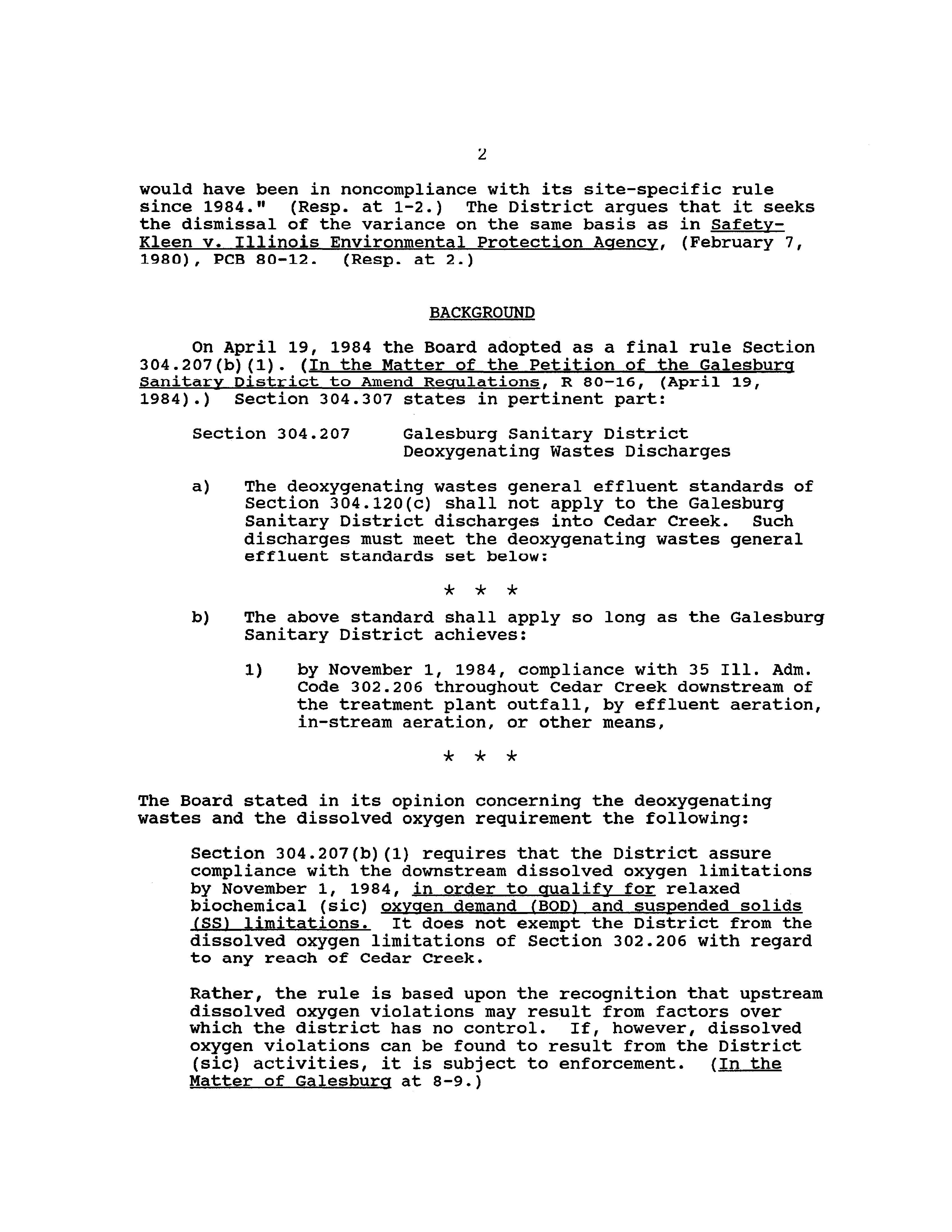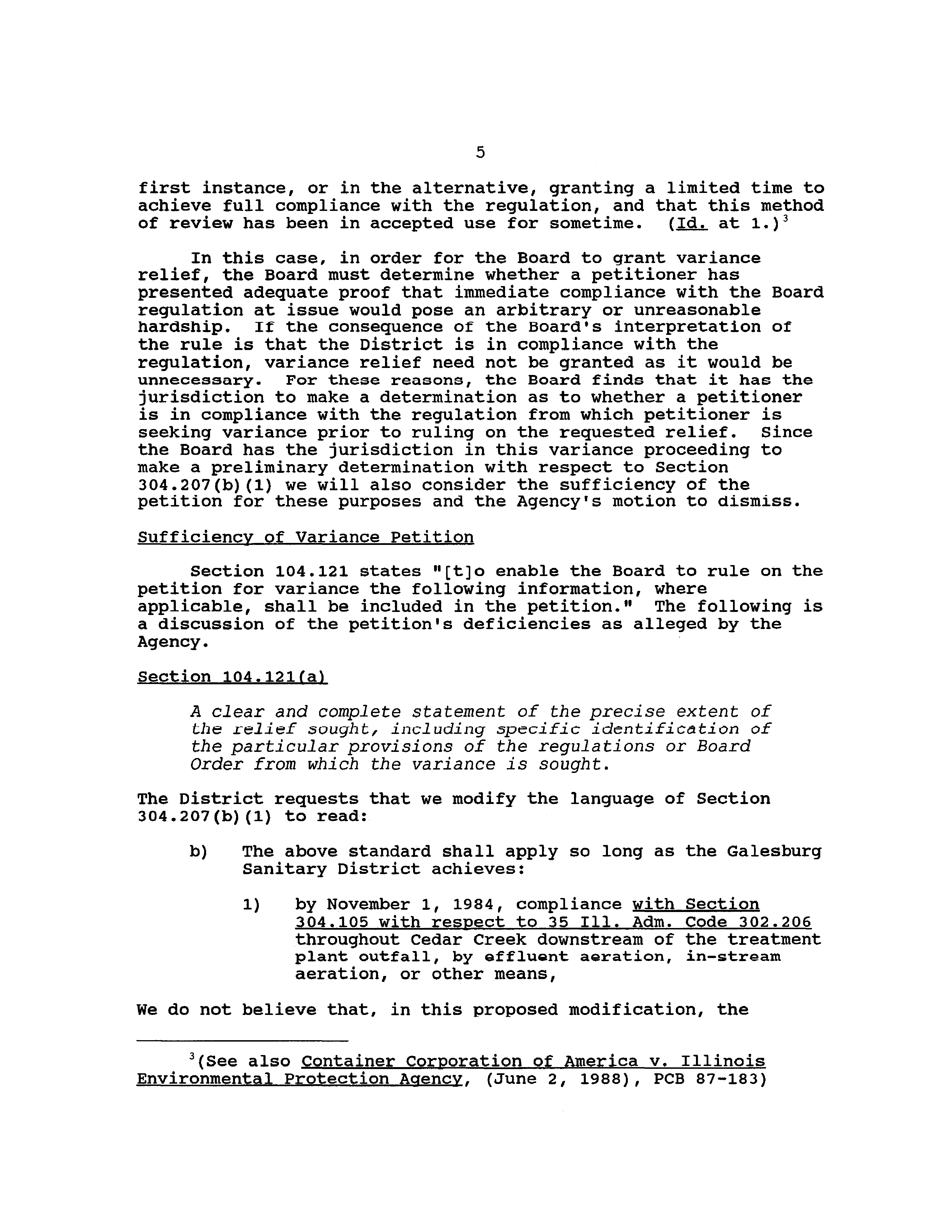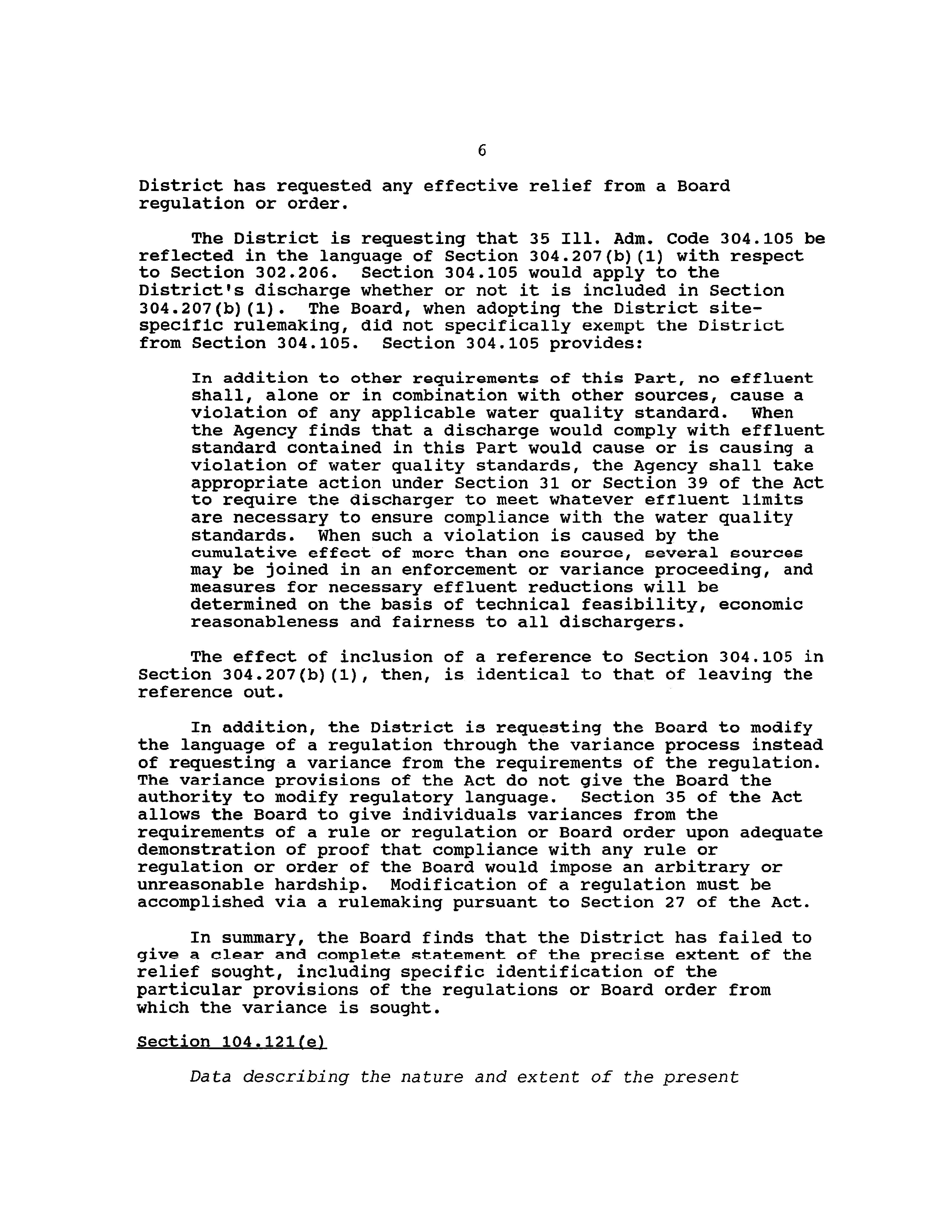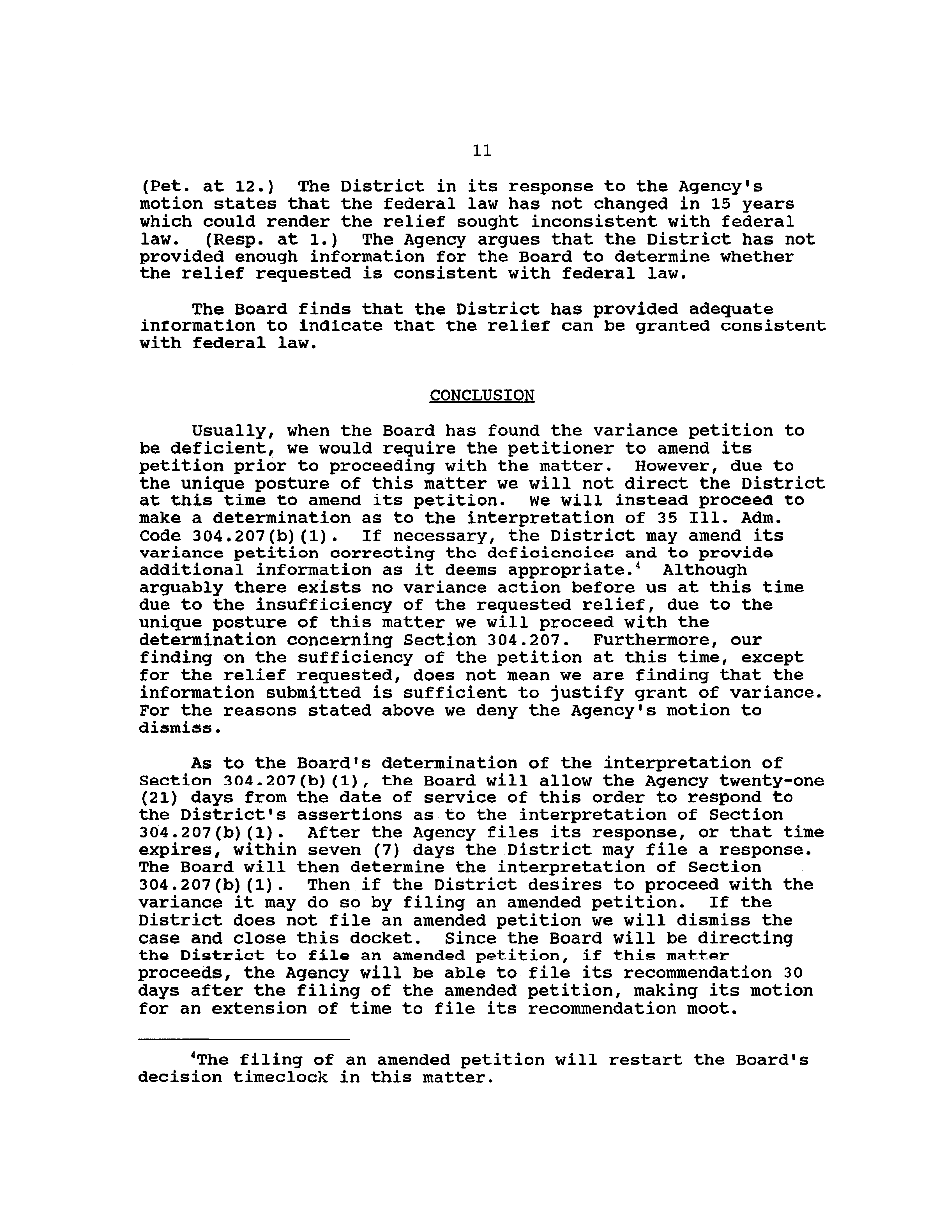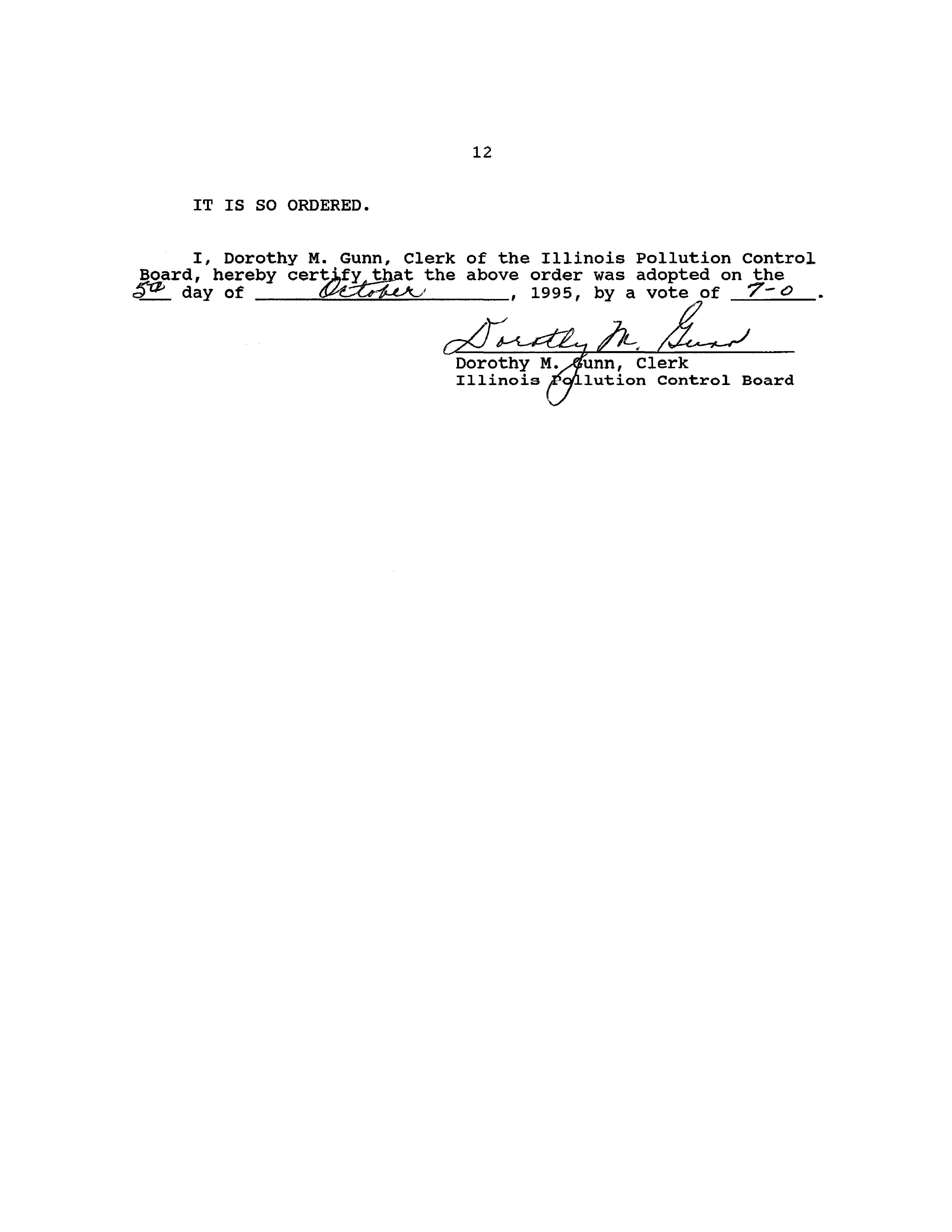ILLINOIS POLLUTION CONTROL BOARD
October 5, 1995
THE GALESBURG SANITARY
)
DISTRICT,
)
Petitioner,
)
PCB 96—46
V.
)
(Variance-Water)
)
ILLINOIS ENVIRONMENTAL
)
PROTECTION AGENCY,
)
)
Respondent.
ORDER OF THE BOARD (by J. Yi):
On August 23, 1995 the Galesburg Sanitary District (District)
filed a petition for variance for its wastewater treatment plant
located at 2700 W. Main Street, Galesburg, Knox County Illinois.
The District is requesting relief from the requirements of 35
Ill. Adm. Code 304.207(b) (1) as this section applies to the
District’s deoxygenating waste discharges. The District filed
the petition pursuant to Section 35 of the Environmental
Protection Act (Act). (415 ILCS 5/35 (1994).) Alternatively,
the District requests the Board to enter a order which dismisses
“...the petition on the basis that the relief requested is
unnecessary in that it reflects the Board’s intent as to how that
rule (35 Ill. Adm. Code 304.207(b) (1)) is to be interpreted.”
(Pet. at 1.)’ Essentially the District is requesting the Board
to interpret its own rule, and if necessary, based on this
interpretation, seeks variance reller.
The Illinois Environmental Protection Agency (Agency) filed
a motion to dismiss the petition as being inadequate and
insufficient on September 7, 1995. Additionally, the Agency
argues that the Board does not have the authority to grant the
relief requested by the District in the context of a variance
petition. The Agency also filed a motion for extension of time
to file its recommendation should the Board not dismiss the
District’s petition.
In response to the Agency’s motion to dismiss the District
states “~the District does not desire to obtain a variance and
if it does obtain a variance, that would imply that the District
‘The petition for variance will be referenced as “Pet. at
“,
the Illinois Environmental Protection Agency’s motion to dismiss
will be referred to as “Mot. at
“,
and the District’s response to
the motion to dismiss will referenced as “Resp. at
“.
2
would have been in noncompliance with its site-specific rule
since 1984.” (Resp. at 1-2.) The District argues that it seeks
the dismissal of the variance on the same basis as in Safety—
Kleen v. Illinois Environmental Protection Agency, (February 7,
19g0), PCB 50—12.
(Resp. at 2.)
BACKGROUND
On April 19,
1984 the Board adopted as a final rule Section
304 .207 (b) (1). (In the Matter of the Petition of the Galesburg
Sanitary District to Amend Regulations, R 80-16, (April 19,
1984).) Section 304.307 states in pertinent part:
Section 304.207
Galesburg Sanitary District
Deoxygenating Wastes Discharges
a) The deoxygenating wastes general effluent standards of
Section 304.120(c) shall not apply to the Galesburg
Sanitary District discharges into Cedar Creek. Such
discharges must meet the deoxygenating wastes general
effluent standards set below:
** *
b) The above standard shall apply so long as the Galesburg
Sanitary District achieves:
1) by November 1, 1984, compliance with 35 Ill. Adin.
Code 302.206 throughout Cedar Creek downstream of
the treatment plant outfall, by effluent aeration,
in-stream aeration, or other means,
The Board stated in its opinion concerning the deoxygenating
wastes and the dissolved oxygen requirement the following:
Section 304.207(b) (1) requires that the District assure
compliance with the downstream dissolved oxygen limitations
by November 1, 1984, in order to qualify for relaxed
biochemical (sic) oxygen demand (BOD) and suspended solids
(SS~ limitations. It does not exempt the District from the
dissolved oxygen limitations of Section 302.206 with regard
to any reach of Cedar Creek.
Rather, the rule is based upon the recognition that upstream
dissolved oxygen violations may result from factors over
which the district has no control. If, however, dissolved
oxygen violations can be found to result from the District
(sic) activities, it is subject to enforcement. (In the
Matter of Galesburg at 8-9.)
3
In explanation of the instant variance petition, the
District states that “ijn the spring of 1994, however, the
Agency raised the issue of whether the District continued to be
entitled to the relief provided by Section 304.207 due to
continuing exceedances of the dissolved oxygen standard in Cedar
Creek.” (Pet. at 2.) Additionally, the District states that it
responded to the Agency’s position by sending information to the
Agency which explained that the Board’s intention is that Section
304.207(b)(l)
“...
should be read in light or Section 304.105
which requires that a discharges not cause or contribute to water
quality violations.” (Pet. at 2.) The Agency sent a Pre-
Enforcement Conference Letter (PECL)
to the District dated June
14, 1995.
(Pet. at
2, Pet. Attachment C.)
The PECL set forth the
statutory and regulatory requirements
and stated
the following:
On April 19, 1984, the Pollution Control Board issued its
Order adopting an adjusted standard tor the Galesburg
Sanitary District discharges, but stated that the relaxed
standards applied so long as the Galesburg Sanitary District
achieved compliance by November 1, 1904 with 35 Ill. Adrn.
Code 302.206 throughout Cedar Creek downstream of
the
treatment plant outfall, by effluent aeration, in—stream
aeration or other means and also complied with other
listed
conditions.
The Board further stated that
if any of these
conditions were not met, the deoxygenating wastes (“D.O.”)
general effluent standards of Section 304.120(c) “shall
apply”(Pet.
Attachmentto
the GalesburgC
at 3)Sanitary
District
into Cedar Creek.2
Based on the PECL and the District’s
failed attempt to
persuade the
Agency to refrain from enforcement, the District
filed this petition to either, a) receive a variance from Section
304.207 (b) (1) or the water quality requirements of Section
302.206 as they apply to Cedar
Creek; or b) a determination from
the Board that the Board intended that the District’s discharges
themselves can not violate Section 302.206 when we adopted
Section
304.207(b) (1).
STATUTORY FRAMEWORK
In determining whether any variance is to be granted, the
Act
requires the Board
to determine whether a petitioner has
presented adequate proof that immediate compliance with
the Board
regulation at issue would pose an arbitrary or unreasonable
2The Board notes that the Agency designates deoxygenating
waste as “D.O.” in the PECL but then proceeds to list sample
results for dissolved oxygen using the “D.O.” as its designation.
4
hardship. (415 ILCS 5/35 (a) (1994).) Furthermore, the burden is
on petitioner to show that its claimed hardship outweighs the
public interest in attaining immediate compliance with
regulations designed to protect the public. (Willowbrook Motel
V.
Pollution Control Board (1st Dist. 1977), 135 Ill.App.3d 343,
481 N.E.2d 1032). Only with such a showing can the claimed
hardship rise to the level of arbitrary or unreasonable hardship.
(We Shred It, Inc. v. Illinois Environmental Protection Agency,
(November 18, 1993) PCB 92—180 at 3.)
A further feature of a variance is that it is, by its
nature, a temporary reprieve from compliance with the ~
regulations, and compliance is to be sought regardless of the
hardship which the task of eventual compliance presents an
individual polluter. (Monsanto Co.
V.
Pollution Control Board,
67 Ill.2d 276, 367 N.E. 2d 684, (1977).) Accordingly, except in
certain special circumstances, a variance petitioner is required
as a condition to the grant of a variance, to commit to a plan
which is reasonably calculated to achieve compliance within the
term of the variance.
DISCUSSION
Jurisdiction
The District is requesting variance relief from a site—
specific rule or in the alternative a determination by the Board
that the requested variance relief is unnecessary. As the
District has noted, the Board has found in prior cases before the
Board that a petitioner was in compliance with the regulation
from which it requested variance relief and consequently
dismissed the variance petition as unnecessary. (See Safety—
Kleen.) However, the Board has also found that a variance
petition is not an appropriate proceeding for a determination as
to whether a certain material was an acceptable alternative for
landfill cover. (See
Lo~ieStar v. Illinois Environmental
Protection Agency, (May 20, 1993), PCB 92-134.) Moreover, the
Board made a preliminary determination as to the applicability of
the regulations in an adjusted standard proceeding. (See In the
matter of Petition of Illinois Wood Energy Partners, L.P. for an
Adlusted Standard from 35 Ill. Adm. Code 807
or~in
the
alternative, a Finding of Inapplicability, (December 1, 1994), AS
94-1.) In doing so the Board reasoned that its jurisdiction in
making such a determination is the result
of the
petitioner
seeking relief from a requirement which would result in violation
if such relief was not granted.
~
at 2.) Finally in ~
Specialty Resins Corporation v. Illinois Environmental Protection
Agency, (April 20, 1995), PCB 95-98, the Board concluded that the
variance proceeding was specifically envisioned by the drafters
of the Environmental Protection Act as an appropriate means of
deciding whether a determination of the Agency was correct in the
5
first instance, or in the alternative, granting a limited time to
achieve full compliance with the regulation, and that this method
of review has been in accepted use for sometime.
~
at i.)~
In this case, in order for the Board to grant variance
relief, the Board must determine whether a petitioner has
presented adequate proof that immediate compliance with the Board
regulation at issue would pose an arbitrary or unreasonable
hardship, If the consequence or the Board’s interpretation or
the rule is that the District is in compliance with the
regulation, variance relief need not be granted as it would be
unnecessary. For these reasons, the Board finds that it has the
jurisdiction to make a determination as to whether a petitioner
is in compliance with the regulation from which petitioner is
seeking variance prior to ruling on the requested relief. Since
the Board has the jurisdiction in this variance proceeding to
make a preliminary determination with respect to Section
304.207(b) (1) we will also consider the sufficiency of the
petition for these purposes and the Agency’s motion to dismiss.
Sufficiency of Variance Petition
Section 104.121 states “to enable the Board to rule on the
petition for variance the following information, where
applicable, shall be included in the petition.” The following is
a discussion of the petition’s deficiencies as alleged by the
Agency.
Section 104. 121 (a~
A clear and complete statement of the precise
extent
of
the
relief sought, including 5pecific identification of
the particular provisions of the regulations or Board
Order from which the variance is sought.
The District requests that we modify the language of Section
304.207(b) (1) to read:
b) The above standard shall apply so long as the Galesburg
Sanitary District achieves:
1) by November 1, 1984, compliance with Section
304.105 with respect to 35 Ill. Adm. Code 302.206
throughout Cedar Creek downstream of the treatment
plant outfall, by effluent aeration, in—stream
aeration, or other means,
We do not believe that, in this proposed modification, the
3(See also Container Corporation of America v. Illinois
Environmental Protection Agency, (June 2, 1988), PCB 87-183)
6
District has requested any effective relief from a Board
regulation or order.
The District is requesting that 35 Ill. Adiu. Code 304.105 be
reflected in the language of Section 304.207(b) (1) with respect
to Section 302.206. Section 304.105 would apply to the
District’s discharge whether or not it is included in Section
304.207(b) (1). The Board, when adopting the District site-
specific rulemaking, did not specifically exempt the District
from Section 304.105. Section 304.105 provides:
In addition to other requirements of this Part, no effluent
shall, alone or in combination with other sources, cause a
violation of any applicable water quality standard. When
the Agency finds that a discharge would comply with effluent
standard contained in this Part would cause or is causing a
violation of water quality standards, the Agency shall take
appropriate action under Section 31 or Section 39 of the Act
to require the discharger to meet whatever effluent limits
are necessary to ensure compliance with the water quality
standards. When such a violation is caused by the
cumulative effect of more than one source, several sources
may be joined in an enforcement or variance proceeding, and
measures for necessary effluent reductions will be
determined on the basis of technical feasibility, economic
reasonableness and fairness to all dischargers.
The effect of inclusion of a reference to Section 304.105 in
Section 304.207(b) (1), then, is identical to that of leaving the
reference out.
In addition, the District is requesting the Board to modify
the language of a regulation through the variance process instead
of requesting a variance from the requirements of the regulation.
The variance provisions of the Act do not give the Board the
authority to modify regulatory language. Section 35 of the Act
allows the Board to give individuals variances from the
requirements of a rule or regulation or Board order upon adequate
demonstration of proof that compliance with any rule or
regulation or order of the Board would impose an arbitrary or
unreasonable hardship. Modification of a regulation must be
accomplished via a rulemaking pursuant to Section 27 of the Act.
In summary, the Board finds that the District has failed to
give a clear and complete statement
of
the precise extent of the
relief sought, including specific identification of the
particular provisions of the regulations or Board order from
which the variance is sought.
Section 104.121(e)
Data describing the nature and extent of the present
7
failure to meet the numerical standards or particular
provisions from which the variance is sought and a
factual statement of why compliance with the Act and
regulations was not or cannot be achieved by the
required compliance date;
The District states that “...since it has been adding more
oxygen to Cedar Creek than the incremental oxygen demand it adds
to the creek (slc) by discharging BOD above the generally
applicable levels, it has complied with Section 304.207(b) (1)
such that relief afforded by Section 304.207 continues to apply.”
(Pet. at 7.) Therefore
the District believes it is complying
with Section 304.207(b) (1). However, the District also states
that if the Agency is correct, in that it has not met the
requirements of Section 302.206 and therefore is not in
compliance as required by Section 304.307(b) (1), it “...cannot
meet the applicable standards with its present plant, as the
discharge data presented demonstrates.” (Pet. at 7.) The Agency
argues that since the District believes that it is in compliance,
the District has failed to provide information describing the
nature and extent of its present failure to meet the
requirements.
(Mot. at 4..)
The Board finds that, at this point in this proceeding the
District has met the informational requirements of Section
104.121(e).
The District has supplied the information necessary
to describe the nature and extent of the present failure to meet
the numerical standards of a particular provisions if the Board
were to determine that the District has failed to meet the
requirements of Section 304. 307(b) (1).
Section 104.121(f)
A detailed description of the existing and proposed
equipment or proposed method of control to he
undertaken to achieve full compliance with the Act and
regulations, including a time schedule for
the
implementation of all phases of the control program
from initiation of design to program completion and
the
estimated costs involved for each phase and the total
cost to achieve compliance;
The District asserts that it is uncertain of its compliance
plan for several reasons, including whether they are actually in
violation, whether the relief being requested in AS 94-20, In the
Matter of: The Galesbura Sanitary District Petition for an
Adjusted Standard from 35 Ill. Adm. Code 304.105 is granted, and
what effects closure of other facilities discharging to the creek
and to the plant will have to the water quality on the creek and
its discharge. (Pet. at 8-9.)
The District offers a compliance plan which concludes with
8
it either building the necessary treatment facilities as required
based on further studies or seeking adjusted standard relief.
(Pet. at 9-10.) However, the plan does not contain specific
information and only estimates the costs for installation of the
digester supernatant treatment and partial nitrification. (Pet.
at 9-10.) The Agency argues that since the plan fails to have
specific information the variance petition is deficient. (Mot.
at 5—6.)
The Board finds that, in this case and at this point in the
proceeding, the District’s variance petition is sufficient
concerning the requirements of Section
104.121(f).
Although the
District has not given many specifics, the Board has granted
variances for studies to be conducted to determine the necessary
compliance plan with a commitment by petitioner’s to the eventual
implementation of such plan. (See Mobil Oil Corp. v. Illinois
Environmental Protection Agency, (March 3, 1994), PCB 93—151.)
Additionally the Board has accepted as part of a compliance plan
the petitioner seeking adjusted standard relief In very unique
situations such as where petitioner has exhausted compliance
options, petitioner is actively pursuing permanent relief, the
term
of
variance is for the limited time ncceo~ary
to
resolve the
matter of permanent relief, and hardship of immediate compliance
clearly outweighs impact of grant of the variance. (See
Akzo
chemicals. Inc. v. Illinois Environmental Protection Agency, (May
5, 1994), PCB 94—76.)
Sectioii. 104. 121(g)
An assessment, with supporting factual information, of
the environmental impact
that
the variance will impose
on human, plant, and animal life in thc czffcctcd arc~,
including, where applicable, data describing the
existing air and water quality which the discharge may
~ f
fec
t;
The District asserts that the
“. .
.requested relief will have
no adverse impact upon the environment in that the District is
not seeking any relief from the dissolved oxygen standard in
Cedar Creek which is the water quality characteristic of concern
in this matter.” (Pet. at 10.) The District also states that,
if it is not in compliance and is required to achieve the
generally applicable standards concerning BOD5 and suspended
solids, it would no longer be required to operate the aerators
which
would
actually increase both in
~~magnitl1de and frequeney~I
the violation of Section 302.206. (Pet. at 10.) The Agency
argues that the District’s petition fails to provide an
evaluation of the impact of the requested relief. (Mot. at 7.)
The Agency argues that the requested relief adds
“. .
.an
additional hoop the Agency would have to jump through to pursue
enforcement” and that “~a)lthough it may be hard to quantify,
contrary to Galesburg’s statement, the Agency believes that such
9
requested relief would have an adverse environmental impact.”
(Mot. at 7.)
At this point of the proceeding, the Board finds that the
impact information is sufficient to meet the requirements of
Section 104.121(g) considering the unique posture of this case.
The District states that if the variance is granted the “status
quo would be maintained.” (Pet. at 10.) The District states it
is not requesting variance relief in order to discharge anything
other than what it is already discharging.
Section 104.121(h)
Past efforts to achieve compliance including costs
incurred, results achieved, permit status, and, for
publicly-owned treatment works or connections thereto,
construction grant status;
The District claims it has been In compliance with Section
304.207 (b) (1) and has made no efforts beyond the installation of
the aerators and injecting more oxygen than is required by
Section 304
•
207(b) (1). (Pet. at 11.) The Agency argues that the
petition is insufficient because it does not provide any
information as to compliance efforts.
The Board finds that the District’s petition has met the
requirements of Section 104.121(h). The District has been
operating under the assumption that it was only required to meet
the standards of Section 302.206 as far as its discharge not
contributing to a violation of the water quality standard for
dissolved oxygen in Cedar Creek. The District states its past
effort was to inject dissolved oxygen into the creek so that the
standards of Section 302.206 are achieved in relation to its
discharge. Since the District believed that by injecting
dissolved oxygen it was in compliance, those were its compliance
efforts and there is no other applicable information.
Section 104.121(i)
A discussion of the availability of alternate methods
of compliance, the extent that such methods were
studied, and the comparative factors leading to the
selection of the control program proposed to achieve
compliance;
As stated previously concerning the requirements of Sect.i.on
104.121(g), the District states that it has not investigated
alternative compliance methods since it believed it was in
compliance and that it is unreasonable to require any further
investigation until the impacts of the closure of Gunther
Products, a company which discharges to the District, and the
Board’s decision in AS 94-20 is known. The Agency argues that
10
the compliance methods have not been investigated and therefore
the petition is deficient. (Not. at 8.)
The Board finds that, at this point in the proceeding, the
District has met the applicable informational requirements of
Section 104.121(i). In this case the District has supplied the
information that is applicable at this time.
Section 104.121(1)
A statement of the measures to be undertaken during the
period of
the
variance to minimize the impact of the
discharge of contaminants on human, plant, and animal
life in the affected area, including the numerical
interim discharge limitations which can be achieved
during the period of the variance;
The District states that there is little it can do to
minimize the environmental impact during the variance term as a
result of its National Pollution Discharge Elimination System
(NPDES) permit limiting the amount of dissolved oxygen levels it
can inject into Cedar Creek at 150 saturation. (Pet. at 11.)
The Agency states that the District’s statements are in direct
conflict with the earlier statement that there is no impact and
asserts that the information made by the District provided is
inadequate to meet the requirements.
The Board finds the information is adequate concerning the
petition for variance. The variance is not requesting the
ability to discharge anything additional to the creek during the
variance, thus the impact of the discharge during the variance
will be the same as it is without the variance. Furthermore,
since there is a question of the interpretation of Section
304.207(b) (1) as it relates to Section 302.206, the District has
provided the applicable information at this time.
Section 104. 122 (b)
All petitions for variances from Title III of the Act; from
35 Ill. Adm. Code, Subtitle C, Ch I; or from water pollution
related requirements of any other title of the Act or
chapter of the Board’s Regulations shall indicate whether
the Board may grant relief consistent with the Clean Water
Act
(33 U.S.C. 1251,),
U.S.E.P.A.
effluent guidelines and
standards, any other Federal regulations, or any areawide
waste treatment management plan approved by the
Administrator of U.S.E.P.A. pursuant to Section 208 of the
Clean Water Act.
The District states that the relief requested is consistent
with federal law and the Board’s intent of Section 304.207(b) (1).
11
(Pet. at 12.) The District in its response to the Agency’s
motion states that the federal law has not changed in 15 years
which could render the relief sought inconsistent with federal
law. (Resp. at 1.) The Agency argues that the District has not
provided enough information for the Board to determine whether
the relief requested is consistent with federal law.
The Board finds that the District has provided adequate
information to indicate that the relief can be granted consistent
with federal law.
CONCLUSION
Usually, when the Board has found the variance petition to
be deficient, we would require the petitioner to amend its
petition prior to proceeding with the matter. However, due to
the unique posture of this matter we will not direct the District
at this time to amend its petition. we will instead proceed to
make a determination as to the interpretation of 35 Ill. Adin.
Code 304
•
207(b) (1). If necessary, the District may amend its
variance petition correcting the deficiencies and to provide
additional information as it deems appropriate.4 Although
arguably there exists no variance action before us at this time
due to the insufficiency of the requested relief, due to the
unique posture of this matter we will proceed with the
determination concerning Section 304.207. Furthermore, our
finding on the sufficiency of the petition at this time, except
for the relief requested, does not mean we are finding that the
information submitted is sufficient to justify grant of variance.
For the reasons stated above we deny the Agency’s motion to
dismiss.
As to the Board’s determination of the interpretation of
Section 304 ..207 (b) (1), the Board will allow the Agency twenty-one
(21) days from the date of service of this order to respond to
the District’s assertions as to the interpretation of Section
304.207 (b) (1). After the Agency files its response, or that time
expires, within seven (7) days the District may file a response.
The Board will then determine the interpretation of Section
304.207(b)(1). Then if the District desires to proceed with the
variance it may do so by filing an amended petition. If the
District does not file an amended petition we will dismiss the
case and close this docket. Since the Board will be directing
the District to file an amended petition, if this matter
proceeds, the Agency will be able to file its recommendation 30
days after the filing of the amended petition, making its motion
for an extension of time to file its recommendation moot.
4The filing of an amended petition will restart the Board’s
decision timeclock in this matter.
12
IT IS SO ORDERED.
I, Dorothy M. ,Gunn, Clerk of the Illinois Pollution Control
Board, hereby cer~~~.batthe above order was adopted on the
~
day of _____________________, 1995, by a vote of 7c~
Dorothy M.,4unn, Clerk
Illinois ~71lution Control Board


